PART 2
Conversation at a Noodle Stand
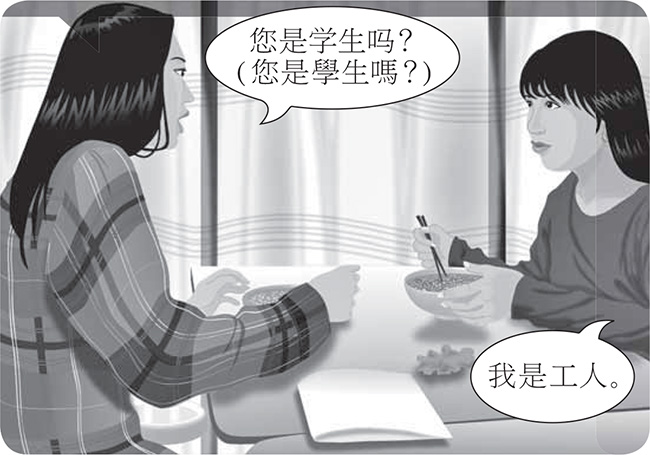
New Characters and Words 
Study the six characters below and the common words written with them, paying careful attention to each character’s pronunciation, meaning, and structure, as well as similar-looking characters. After you’ve studied a character, turn to the Practice Book volume and practice writing it on the practice sheet, making sure to follow the correct stroke order and direction as you pronounce it out loud and think of its meaning.
151 |
吃 |
chī |
eat |
Radical is 口 kŏu “mouth.” This radical is referred to colloquially as 口字旁 kŏuzìpáng “side made up of the character 口.” Phonetic is 乞 qĭ “beg” as in 乞丐 qĭgài “beggar.” When a person “begs” and points to their “mouth,” they want something to “eat.” |
|||
吃 |
chī |
eat [V] |
|
152 |
饭(飯) |
fàn |
cooked rice, food |
Radical is 食 shí “eat” [BF], which is written as 饣(飠) when occurring at the left side of a character as a radical. The colloquial name for this radical is 食字旁 shízìpáng “side made up of the character 食.” Phonetic is 反 as in 反对 ( 反對 ) fănduì “oppose.” |
|||
饭 (飯) |
fàn |
cooked rice, food [N] |
|
吃饭 (吃飯) |
chīfàn |
eat food, eat [VO] |
|
中饭 (中飯) |
zhōngfàn |
lunch [N] |
|
中国饭 (中國飯) |
Zhōngguo fàn |
Chinese food [PH] |
|
153 |
学(學) |
xué |
learn, study |
Radical is 子 zĭ “child” [BF]. It is fitting for a “child” to “learn.” Contrast 学 (學) with 兴 (興) xìng (90), 字 zì (84), and 李 lĭ (20). |
|||
学 (學) |
xué |
learn, study [V] |
|
同学 (同學 ) |
tóngxué |
classmate [N] |
|
学生 (學生 ) |
xuésheng |
student [N] |
|
男学生 (男學生) |
nánxuésheng |
male student [N] |
|
女学生 (女學生) |
nǚxuésheng |
female student [N] |
|
大学 (大學 ) |
dàxué |
university, college [N] |
|
大学生 (大學生) |
dàxuéshēng |
college student [N] |
|
香港中文大学 (香港中文大學) |
Xiānggăng Zhōngwén Dàxué |
Chinese University of Hong Kong [PW] |
|
154 |
工 |
gōng |
work |
This character is itself a radical. It is itself also a very common phonetic, e.g., in 功 gōng as in 成功 chénggōng “succeed,” 攻 gōng as in 攻打 gōngdă “attack,” 贡 (貢) gòng as in 贡献 (貢獻) gòng-xiàn “contribution,” 缸 gāng as in 水缸 shuĭgāng “water vat,” 江 jiāng as in 长江 (長江) Cháng Jiāng “Chang Jiang (river),” and 红 (紅) hóng “red.” 工 is a picture of an ancient carpenter’s tool, with the lower part representing the blade and the other two strokes representing the handle. By extension, 工 acquired the meaning “work.” Contrast 工 with 二 èr (2) and 王 wáng (6). |
|||
工人 |
gōngrén |
worker, laborer [N] |
|
155 |
子 |
zĭ/zi |
(common noun suffix) |
This character is itself a radical. It also serves as a phonetic, e.g., in 字 zì “character” and 仔 zăi as in 牛仔裤 (牛仔褲) níuzăikù “jeans.” In Classical Chinese, pronounced with a Third Tone as zĭ, 子 means “son” or “child.” As a noun suffix, 子 is pronounced in the neutral tone. 子 is a pictograph, showing a newborn child swathed so that its arms show but its legs are not visible. Contrast 子 with 了 le (71), 千 qiān (114), and 字 zì (84). |
|||
位子 |
wèizi |
seat, place [N] |
|
156 |
儿(兒) |
ér |
(common suffix) |
儿 is itself a radical. The traditional form of the character, 兒, has an alternate form, 児. The suffix 儿 (兒), while typical of Beijing colloquial speech, is usually dropped in standard written Chinese, except in direct quotations such as in novels, so one says 一点儿 (一點兒) but normally writes 一点 (一點). Remember that儿 (兒), when functioning as a suffix, combines with the preceding syllable and isn’t pronounced by itself, so one pronounces 一点儿 (一點兒) as yìdiănr, not as *yìdiăn’ér. Contrast simplified 儿 with 九 jiŭ (10) and simplified 几 jĭ (97). |
|||
这儿 (這兒) |
zhèr |
here [PW] |
|
那儿 (那兒) |
nàr |
there [PW] |
|
哪儿 (哪兒) |
năr |
where? [QW] |
|
一点儿 (一點兒) |
yìdiănr |
a little, some [NU + M] |
|
门儿 (門兒) |
ménr |
door, gate [N] |
|
同屋儿 (同屋兒) |
tóngwūr |
roommate [N] |
|
一半儿 (一半兒) |
yíbànr |
half [NU + NU] |
|
一半儿一半儿 (一半兒一半兒) |
yíbànr yíbànr |
half and half |
|
New Words in BMC–SL 5-2 Written with Characters You Already Know 
北大 |
Bĕidà |
Peking University [PW] |
Reading Exercises (Simplified Characters) 
Now practice reading the new characters and words for this lesson in context in sentences, conversations, and narratives. Be sure to refer to the Notes at the end of this lesson, and make use of the accompanying audio disc to hear and practice correct pronunciation, phrasing, and intonation.
A. SENTENCES
Read out loud each of the following sentences, which include all the new characters of this lesson. The first time you read a sentence, focus special attention on the characters and words that are new to you, reminding yourself of their pronunciation and meaning. The second time, aim to comprehend the overall meaning of the sentence.
一、美国人吃美国饭,中国人吃中国饭。 你是哪国人?你吃什么饭?
二、这儿很好,也不贵。 老师、学生、工人都可以在这儿吃中饭。
三、南京大学也叫南大,在南京市,有32,000个学生,有500多位老师。
四、我们要吃饭了。 请男学生坐这儿,请女学生坐那儿。
五、这个位子不太好,那个位子比较好,请您坐那儿吧!
六、我找北京大学。您知道北大在哪儿吗?是不是在这儿?
七、我找高子文,他是我在台大的同学。 您知道他在哪儿吗?
八、那个女的好像不是一个大学生,她是一个工人吧。
九、今年在很多美国大学,学中文的女学生多,男学生少。
十、大海,你不要走,先吃一点儿饭吧。
B. CONVERSATIONS
Read out loud the following conversations, including the name or role of the person speaking. If possible, find a partner or partners and each of you play a role. Then switch roles, so you get practice reading all of the lines.
一、
万小姐:李老师,你今年有多少男学生,多少女学生?
李老师:一半儿一半儿吧。
万小姐:你有多少中国学生,多少美国学生?
李老师:也是一半儿一半儿吧。
万小姐:李老师,这儿的学生去哪儿吃饭呢?
李老师:这个 ⋯⋯ 我就不知道了。
二、
美国人:“港大”是香港中文大学吧?
香港人:不是,“港大”是香港大学,不是香港中文大学。 香港中文大学叫“中大”。
美国人:广州的中山大学不是也叫“中大”吗?
香港人:对,可是 ⋯⋯
三、
学生:请问,这个位子有人吗?
工人:没有,没有。 你坐吧。
学生:谢谢!
工人:你第一次来这儿吃饭吗?
学生:不,我来过很多次。 你是学生吗?
工人:不,我是工人。 你呢?
学生:我是美国来的大学生,今年在北大学中文。
工人:一点钟了,我走了。
学生:我也走了。
C. CHARACTER DIFFERENTIATION DRILLS
Distinguish carefully the following similar-looking characters, pronouncing each one out loud and thinking of its meaning.
一、工 工 工 二 二 二
二、工 工 工 三 三 三
三、工 工 工 王 王 王
四、工 王 三 工 二 工 王 工
五、子 子 子 了 了 了
六、子 子 子 字 字 字
七、子 子 子 千 千 千
八、子 了 字 子 千 子 了
九、学 学 学 字 字 字
十、学 学 学 兴 兴 兴
十一、学 兴 字 学 兴 字 学
十二、儿 儿 儿 几 几 几
十三、儿 儿 儿 九 九 九
十四、儿 九 几 儿 几 九 儿
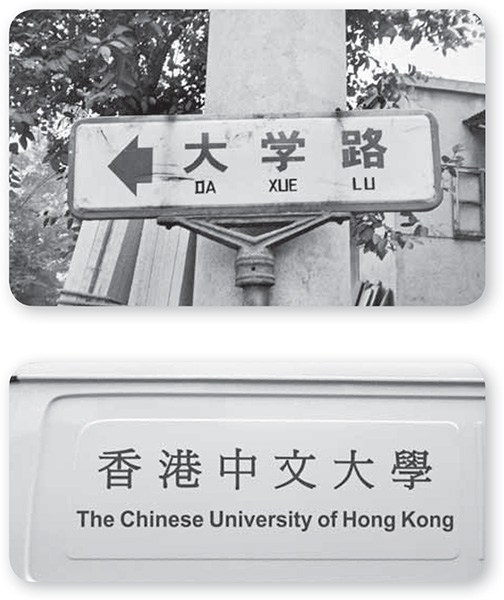
D. NARRATIVES
Read the following narratives, paying special attention to punctuation and overall structure. The first time you read a narrative, read it out loud; the second time, read silently and try to gradually increase your reading speed. Always think of the meaning of what you’re reading.
一、 |
我们大学在台湾是很好的大学,叫台湾大学,也叫“台大”。台大在台北市。这个大学很大,有差不多三万个学生,有三千多位老师。台大的学生都很好,在那儿要找好的老师也不太难。我是台大的学生,这是我在那儿的第一年。我姐姐也是台大的学生,这是她的第三年。 |
二、 |
那个美国大学生问我,在哪儿学中文比较好?我知道在北大学中文很好。那儿有很多很好的中国学生,美国学生也不少。那儿的老师也都比较好。美国学生可以在北大住,也可以在那儿吃饭,都不贵。吃,住一个月好像一千多块钱。中文很难,可是你要是要学,在北大学比较好。这是北京大学王国安老师的名片。你明天可以去北大找王老师问问。 |
E. SUPPLEMENT: A POPULAR SAYING
Read out loud the following saying, which was popular in Taiwan in the 1960s.
来、来、来,来台大,去、去、去,去美国。
Reading Exercises (Traditional Characters) 
A. SENTENCES
Read out loud each of the following sentences, which include all the new characters of this lesson. The first time you read a sentence, focus special attention on the characters and words that are new to you, reminding yourself of their pronunciation and meaning. The second time, aim to comprehend the overall meaning of the sentence.
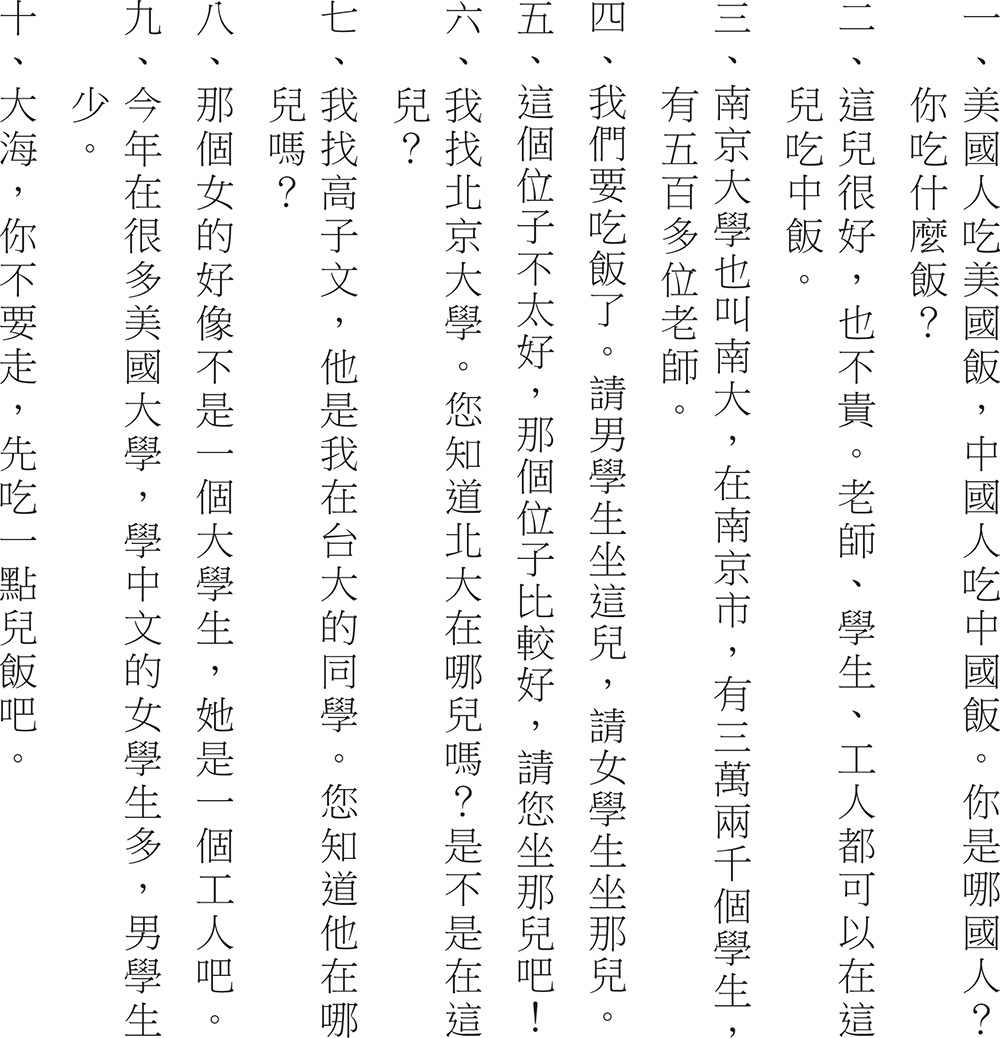
B. CONVERSATIONS
Read out loud the following conversations, including the name or role of the person speaking. If possible, find a partner or partners and each of you play a role. Then switch roles, so you get practice reading all of the lines.
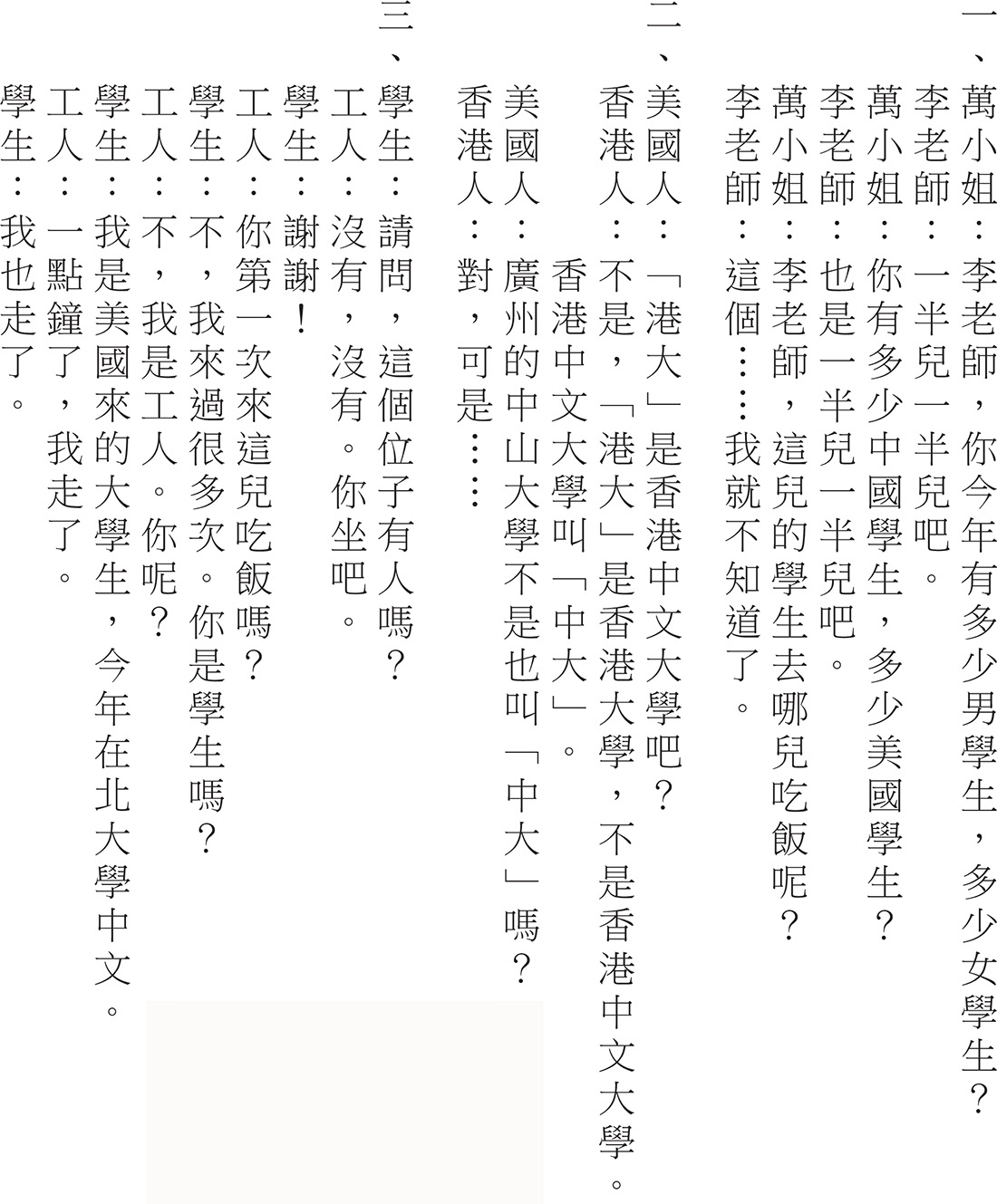
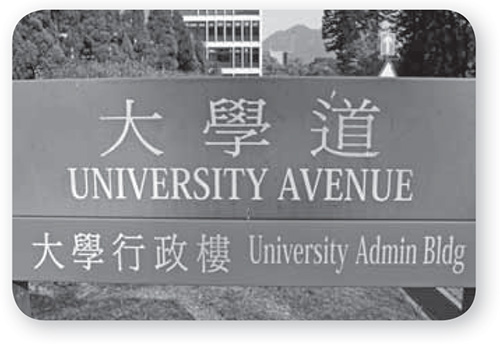
Campus of Chinese University of Hong Kong
C. CHARACTER DIFFERENTIATION DRILLS
Distinguish carefully the following similar-looking characters, pronouncing each one out loud and thinking of its meaning.
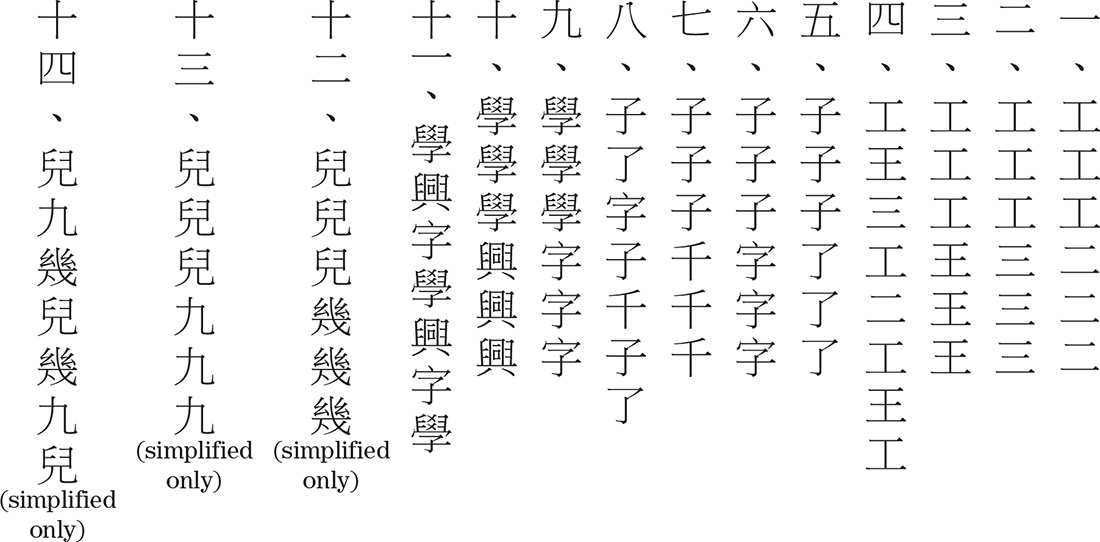
D. NARRATIVES
Read the following narratives, paying special attention to punctuation and overall structure. The first time you read a narrative, read it out loud; the second time, read silently and try to gradually increase your reading speed. Always think of the meaning of what you’re reading.
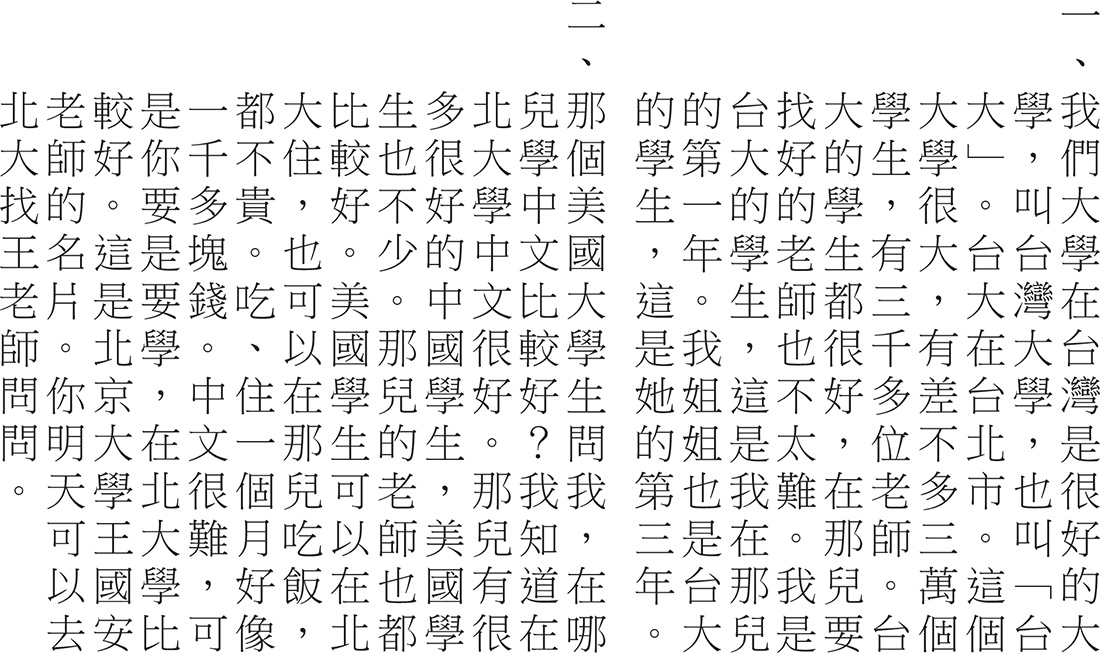
E. SUPPLEMENT: A POPULAR SAYING
Read out loud the following saying, which was popular in Taiwan in the 1960s.
來、來、來、來台大,去、去、去,去美國。
Notes
A7. 他是我在台大的同学 (他是我在台大的同學) “He’s a classmate of mine at Taiwan University.”
A9. 学中文的女学生多,男学生少 (學中文的女學生多,男學生少) “There are many female students studying Chinese, but few male students” (lit. “Female students who study Chinese are many, male students are few”). In the case of starkly contrasting clauses like this, in Chinese it’s often not necessary to have a 可是 or 不过 (不過). However, a “but” can sometimes be added to the English to make the translation smoother.
B3. 我是美国来的大学生 (我是美國來的大學生) “I’m a college student from America.”
D2. 你明天可以去北大找王老师问问 (你明天可以去北大找王老師問問) “Tomorrow you can go to Peking University and look for Teacher Wang and ask.” Regarding the verb duplication of 问问 (問問), as was mentioned in BMC–SL 3-3: 5a, some one-syllable verbs are frequently reduplicated (i.e., repeated) so as to give a relaxed, casual sense to the verb and make the sentence they occur in sound smoother and less abrupt. The meaning is the same as when they are not reduplicated. Note that 问问 (問問) is pronounced with a neutral tone on the second syllable as wènwen, not as *wènwèn.
E. This saying was popular in Taiwan in the 1960s, a time when modern economic development was just beginning and many people wished to go to the U.S. for graduate study. The idea was that if you studied hard and did well on the college entrance exam, you could “come to Taiwan University” and then, after graduation, you could “go to America” for graduate study and, perhaps, to find a well-paying job.
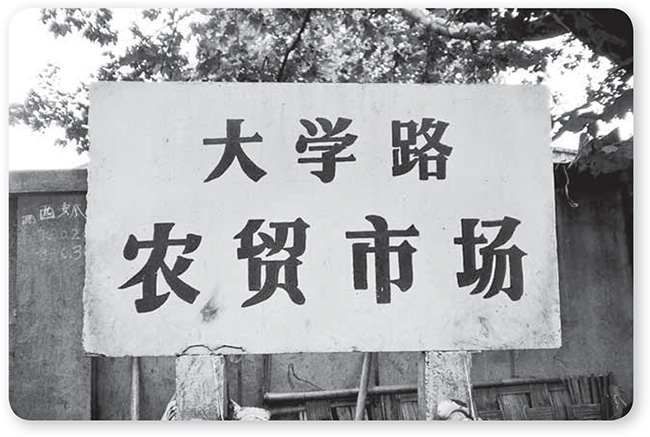
“University Road Farmers’ Market”